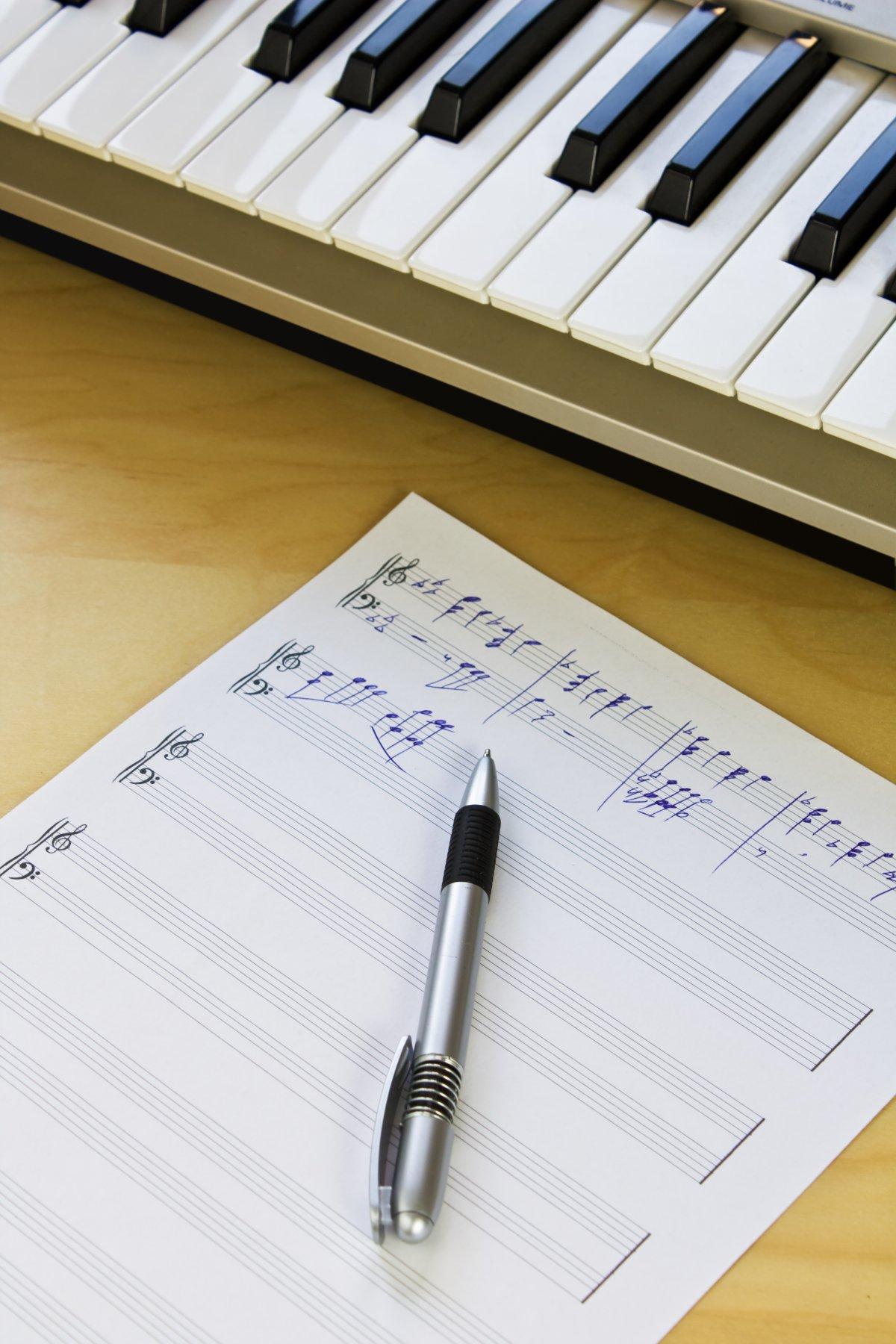Looking for information about how to write a song? If so, you’re in the right place! In this guide, we’re going to share everything you need to know.
If you’ve already tried your hand at songwriting, you probably know how amazing it feels to create your own music and express yourself through lyrics, chords, and melodies!
As you learn how to make a song, you may notice that every tutorial is a bit different. That’s normal, as the process of writing music is different for everyone! Some write the lyrics first, some the chord progression, and others a melody. Some might start with a title and build from there and others may start with an emotion or a personal event that they want to share through the art of song. All of these methods are perfect for writing songs.
How Do You Write a Song?
As we share our tips on how to write songs for beginners, feel free to skip around to different sections as you see fit. Find whatever gets you “into the flow” of your artistic self, and go from there!
This guide will go over each of these steps for writing a song…
Finding Inspiration for Writing a Song
First things first: set your surroundings up for songwriting, since ideas can come to you at any time. This goes for those just learning how to write a song and the pros!
You’ll want to get those ideas committed to paper, a computer, or a voice recorder as soon as possible. So make sure you keep good quality pens in your home, work environment, and car. You can also keep a note on your phone. Whatever works best!
If you can get to your phone’s recorder quickly, you can sing a melodic idea or say your lyrical idea and save it for a later time. And always have blank notebooks or journals around. Even a one-word title is worth writing down so that you don’t forget what it was later on.
Pro tip: When you come up with ideas, browse a rhyming dictionary like this one to help you come with your lyrics. You can also use a thesaurus to find more interesting words.
Ready to get inspired? Here are some ideas to help you:
- Make a list of the musicians and songs that are meaningful to you.
- Set your alarm clock tone to a song you like and change it up often.
- Play different playlists during various parts of your day: getting ready for work, cleaning your house, driving, etc.
Determine Your Song’s Structure
By analyzing songs you enjoy, you can get an idea of some of the different structures that you can use. And as you learn how to write a song, you can play around with different types of song structures until you find the best possible match.
Song Structure – Example One
The simplest structure is that in which there is only one type of lyric, the verse (we call it “A”).
The classic Gershwin tune “Summertime” has an A-A structure, with only two verses (although some singers repeat either the first verse or both verses).
Check out the video below to listen to the Norah Jones/Marian McPartland version.
Song Structure – Example Two
Songs with both verses and choruses have two types of lyrics — we call the verse “A” and the chorus “B.”
The famous Bob Dylan song, “Blowin’ in the Wind,” has this type of structure – A-B-A-B-A-B.
Watch Peter, Paul, and Mary performing the tune below.
Song Structure – Example Three
Other songs are more complex. They may have verses, choruses, and a bridge (which we call “C”).
The Beatles’ “Ticket to Ride” is one of these songs — its structure is A-B-A-B-C-A-B.
Listen to it here:
How to Write Lyrics
As you write your lyrics, keep in mind that there’s no right way to get started! You might already have a few words that you’ve written down, a story or message you want to get across. You may even have the full chorus figured out.
Wherever you start, it can be helpful at some point to describe the entire scope of your song in a single sentence at the top of your lyric writing page. This will help you stay focused. For “Ticket to Ride,” for example, the sentence could be “My girlfriend is moving away from me and I am sad, but she doesn’t care.”
A song is a very short form of art, so it is essential to tie it together with just one idea. If you have too many ideas, break them apart and write a different song for each idea that you have instead of trying to pile too much into one song.
Remember: You don’t have to create an entire song in one sitting. You could just create one verse or one chorus and keep coming back to add more lyrics as you become inspired.
Feeling stuck? Take a look at these:
» 25 Prompts for Songwriting
» Songwriting Tips: 11 Helpful Examples From 7 Hit Songs
» 10 Must-Read Tips for Aspiring Singer-Songwriters
» How to Write a Song for Beginners to Piano
» 5 Mistakes To Avoid When Writing Lyrics via Songtrust
Writing Music: the Melody and Chords
As you experiment with different melodies and chords, this is a perfect time to use some sort of recorder on your phone or on your computer. Try simply singing your lyrics in different ways at least three times, then listen back to your recording and see if you have any keepers.
You could also start with some chords instead. Play some chord progressions on guitar or piano and record those. Then try out some melodies against those chords using your lyrics, if you have those ready.
Or you could try both chords and melodies at the same time. Again, it’s a great idea to record your experiments so you can really fine-tune which melodies and chords are working and which ones could be tweaked to your satisfaction.
If you are having trouble coming up with a chord progression, you could always “borrow” one from another song. Choose a song in a similar style and tempo to yours and combine the chords with your own lyrics.
For an example, if you are writing a folk song, you can “borrow” the chords to “Blowin’ in the Wind,” which has a chorus of Bb – C- F – Dm.
You can use any portion of these chords that works for you. Just make sure that you don’t copy the actual melody of your borrowed tune. Song melodies are protected by copyright law, but chord progressions are not, so you can borrow chord progressions any time you like.
Additional Resources:
» 4 Easy Steps to Writing Your First Song on the Guitar
» How to Write a Song When You Know Next to Nothing About Guitar
» 9 Steps for Writing a Hit Song on the Piano
Writing Your Song’s Title
Of course, your song needs a great title! Many songwriters use the “hook” or repeated words from the chorus as the title of the song. That is true in both “Blowin’ in the Wind” and “Ticket to Ride.”
With “Summertime,” there is no chorus. But the word “summertime” is the first thing you hear in the song and it makes a lasting impression as the title.
Other songs use a descriptive term as the title that is not contained in the lyrics at all. The Beatles’ “A Day in the Life” is an example of this type of title.
Check out the video below and really listen to the lyrics to see why that song title was chosen.
How to Write Music for Beginners: Final Steps
So, what to do after song writing? Once you’ve finished your song, set it aside for a few days. This allows you to come back to it with fresh eyes and ears so you’ll be able to identify lyrics that need tweaking, chords that need adjusting, or other small details to really make the song pop.
After that, here are a few ideas for showing off your new song:
- Perform your song live at an open mic night or simply in front of your music teacher who can help you get the kinks out. (Feeling nervous about that? You’re not alone. Check out our guide to overcoming stage fright for tips!)
- Record your song either in a recording studio or take a stab at recording in a home studio with the equipment you have. With technology today, it’s easy to record your own songs with the right software and a quality microphone.
- If you’re not a singer or performer, you can still get your work produced. Tools like Tunedly allow you to connect with professional musicians to create quality songs suitable for placement opportunities.
- If you’re really feeling confident with your song, consider entering a songwriting contest! There are tons of options and we’ve rounded up several for you.
Songwriting and Singer-Songwriter Contests
Once you get the hang of writing songs, check out these contests you can enter your song into. Qualifications, entry requirements, and awards vary.
- John Lennon Songwriting Contest
- International Acoustic Music Awards
- International Songwriting Competition
- The Great American Song Contest
- American Songwriter Lyric Contest
- West Coast Songwriters
- Chris Austin Songwriting Contest
- America’s Songwriting Contest
- The Search for the Next Great American Songwriter
- Songdoor International Songwriting Competition
Good luck and have fun!
 Post Author: Gfire M.
Post Author: Gfire M.Gfire teaches music theory, opera voice, piano, singing, and songwriting in Austin, TX. She earned her Bachelor of Arts in Music from University of Maryland, as well as her Master of the Science of Singing from Ernest George White Society. Learn more about Gfire here!
Maria Kusior
